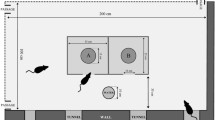Abstract
The Australian brushtail possum (Trichosurus vulpecula) is the major vertebrate pest in New Zealand. Possums cause significant damage to the country's native and exotic forests and, as a vector of bovine tuberculosis, are a serious threat to the country's meat industry. Strong smelling odors are often used as lures during possum control operations in New Zealand, but little is known about the preferences of possums for these odurs. A test was designed to determine the preferences of captive wild possums for a number of odors commonly used as lures. To assess the effectiveness of the method, the possums were tested for their responses to a familiar food odor (apple) versus no odor. The possums spent significantly more time investigating the apple odor and also sniffed it more often than the no-odor control in the 15-min test period. The same procedure, however, showed that five odors commonly used as lures (almond, cloves, cinnamon, peanut, and orange) were no more preferable than water. Our results suggest that these unfamiliar odors are either equally attractive or unattractive to possums and that odors that are more familiar to these animals may be more appropriate as lures.
Similar content being viewed by others
REFERENCES
Batchelor, C. L., and Cowan, P. E. 1988. Review of the status of the possum in New Zealand. Commissioned by Technical Advisory Committee (Animal Pests).
Breslow, N. E., and Clayton, D. G. 1993. Approximate inference in generalized linear mixed models. J. Am. Stat. Assoc. 88(421):9–25.
Brown, R. E. 1979. Mammalian social odours: A critical review. Adv. Study. Behav. 10:103–162.
Clapperton, B. K., Minot, E. O., and Crump, D. R. 1988. An olfactory recognition system in the ferret Mustela furo L. (Carnivora: Mustelidae). Anim. Behav. 36:541–553.
Cowan, P. E. 1987. The influence of lures and relative opportunity for capture on catches of brushtail possums, Trichosurus vulpecula. N.Z. J. Zool. 14:149–161.
Crawley, M. C. 1973. A live-trapping study of Australian brush-tailed possums, Trichosurus vulpecula (KERR), in the Orongorongo Valley, Wellington, New Zealand. Aust. J. Zool. 21:75–90.
Deag, J. M. 1993. Keybehaviour: A program for recording behavioural data on the IBM personal computer, Edinburgh, Scotland.
Ekdahl, M. O., Smith, B. L., and Money, D. F. L. 1970. Tuberculosis in some wild and feral animals in New Zealand. N.Z. Vet. J. 18:44–45.
Food Regulations Act. 1984. Regulation 87–General standard for edible fats and edible oils. Stat. Regul. 3:232–352.
Genstat 5 Committee. 1993. Genstat 5 Release 3 Reference Manual. Clarendon Press, Oxford.
Gilmore, D. P. 1967. Present ways of opposum control held to be a wasteful failure. N.Z. J. Agric. 115:50–55.
Halpin, Z. T. 1978. The effects of social experience on the odour preferences of the mongolian gerbil (Meriones unguiculatus). Biol. Behav. 3:169–179.
Holmes, D. J. 1992. Sternal odours as cues for social discrimination by female Virginia opossums, Didelphis virginiana. J. Mammal. 73:286–291.
Johnston, R. E. 1977. Sex pheromones in golden hamsters, pp. 225–249, in D. Müller-Schwarze and M. M. Mozell (ed.). Chemical Signals in Vertebrates. Plenum Press, New York.
Kean, R. I. 1975. Growth of opossums (Trichosurus vulpecula) in the Orongorongo Valley, Wellington, New Zealand, 1953–61. N.Z. J. Zool. 2:435–444.
Livingstone, P. H. 1991. Tuberculosis in New Zealand, Where have we reached? pp. 113—123, in R. Jackson (convenor). Symposium on Tuberculosis. Vet. Continuing Educ. 132:113–123.
Matthews, L. R. 1977. Dairy cow food preference: A quantitative assessment. MSc thesis. University of Waikato, Hamilton, New Zealand, 78 pp.
Matthews, L. R. 1983. Measurements and scaling of food preferences in dairy cows: Concurrent schedule and free-access techniques. Ph.D. thesis. University of Waikato, Hamilton, New Zealand, 236 pp.
Morgan, D. R. 1990. Behavioural response of brushtail possums, Trichosurus vulpecula, to baits used in pest control. Aust. Wildl. Res. 17:601–613.
Morgan, D. R., Innes, J., Frampton, C. M., and Woolhouse, A. D. 1995. Responses of captive and wild possums to lures. N.Z. J. Zool. 22:123–129.
Patterson, H. D., and Thompson, R. 1974. Recovery of interblock information when block sizes are unequal. Biometrika 58:545–554.
Porter, R. H., and Etscorn, F. 1976. A sensitive period for the development of olfactory preference in Acomys cahirinus. Physiol. Behav. 17:127–130.
Pracy, L. T. 1974. Introduction and liberation of the opossum (Trichosurus vulpecula) into New Zealand. New Zealand Forest Service Information Series No. 45, Forest Service, Rotorua, New Zealand, 15 pp.
Rozin, P. 1976. Psychobiological and cultural determinants of food choice. Life Sci. Res. Rep. 2:285–312.
Russell, E. M. 1987. The metatherians: Order Marsupialia, pp. 45–104, in R. E. Brown and D. W. MacDonald (eds.). Social Odours in Mammals, Vol. 1. Clarendon Press, Oxford.
Shumake, S. A. 1978. Food preference behaviour in birds and mammals, pp. 21–42, in R. W. Bullard (ed.). Flavour Chemistry of Animal Foods. American Chemical Society Symposium Series 67, American Chemical Society, Washington, D.C.
Shumake, S. A., Thompson, R. D., and Bullard, R. W. 1973. An automated odor test for rats. Behav. Res. Methods Instrum. 5:279–282.
Stern, J. J. 1970. Responses of male rats to sex odors. Physiol. Behav. 5:519–524.
Stewart, A. D., Manning, A., and Batty, J. 1980. Effects of Y-chromosome variants on the male behaviour of the mouse Mus musculus. Genet. Res. 35:261–268.
Theobald, C. M., and Goupillot, R. P. 1990. The analysis of repeated latency measures in behavioural studies. Anim. Behav. 40:484–490.
Valsecchi, P., Moles, A., and Mainardi, M. 1993. Does mother's diet affect food selection of weanling wild mice? Anim. Behav. 46:827–828.
Walker, L. V., and Croft, D. B. 1990. Odour preferences and discrimination in captive ringtail possums (Pseudocheirus peregrinus. Int. J. Comp. Psychol. 3:215–234.
Winberg, S., and Olsen, K. H. 1992. The influence of rearing conditions on the sibling odour preferences of juvenile arctic charr, Salvelinus alpinus L. Anim. Behav. 44:157–164.
Author information
Authors and Affiliations
Rights and permissions
About this article
Cite this article
Todd, J.H., O'Connor, C.E. & Waas, J.R. Laboratory Evaluation of Odor Preferences of the Brushtail Possum. J Chem Ecol 24, 439–449 (1998). https://doi.org/10.1023/A:1022356617962
Issue Date:
DOI: https://doi.org/10.1023/A:1022356617962




